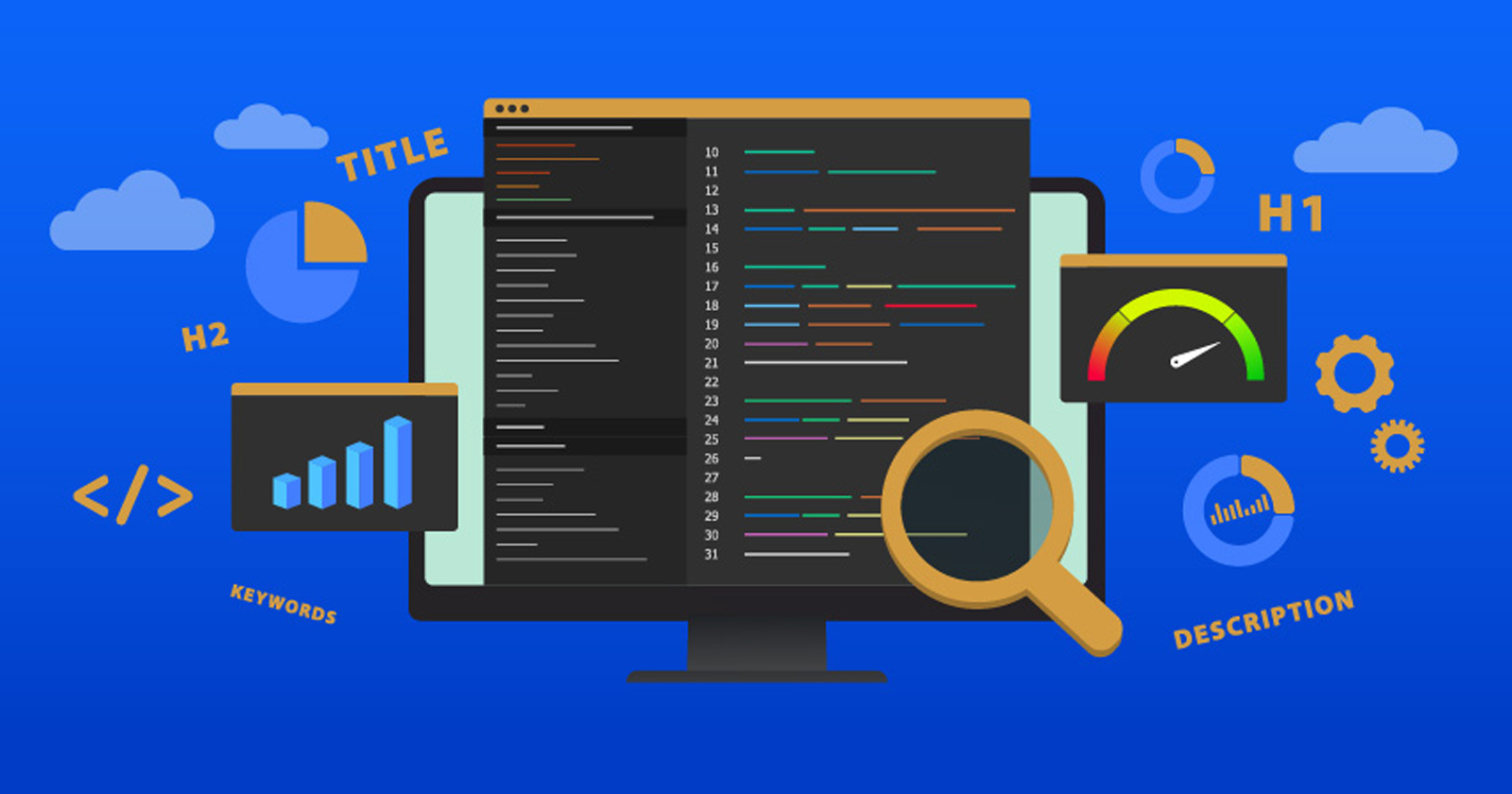You must have a website and implement the most effective SEO techniques to rank high on SERPs as a business owner. But are you aware of the differences between on-page and off-page SEO?
On-page SEO focuses on optimizing website components, such as keyword density and page speed. It refers to actions on your website, such as content optimization and navigation streamlining, to improve search engine ranks.
In contrast, off-page SEO concentrates on elements outside your website that influence your search engine rankings. It refers to actions outside your website, like getting backlinks from other leading sites to improve search engine ranks.
Highly experienced and skilled SEO professionals clearly understand their differences and implement the most effective techniques.
As this post is all about on-page SEO, you will get to learn what it is, why and how to optimize it, evaluate the optimization, and monitor your competitor’s brand performance.
Let’s dive in.
What is On-page SEO?
On-page SEO is an optimization that your website includes, and you can control. If you work on SEO, it drives traffic to your website and increases conversions. If you work on SEO, it drives traffic to your website and increases conversions. On-page optimizations can make your website user-friendly and boost online visibility and search engine ranks.
When it comes to on-page SEO, you need to optimize certain factors to improve search results and enhance your website. Here are the factors that you should optimize:
- Keywords
- URL
- Heading tags
- Title tags
- Meta descriptions
- Content
- Mobile-friendliness
- Images
- ALT tags
- Internal linking
- Speed
To get the best results for on-page SEO, you need to write high-quality and informative content, optimize meta descriptions and title tags, clean website code, streamline navigation, and speed up the website.
Why Should You Prioritize On-page SEO?
Google crawls your website content to understand if it is a relevant result for the user search query. The crawling process involves searching relevant trending keywords.
On-page SEO is much more than adding keywords to your content. Google looks for the most relevant search results for a query and thus, their algorithms look for other related content on a website. If your website is about cosmetics, you don’t specify various breeds. Google knows there may be more relevant search results online.
As relevance is a significant part of on-page SEO, you should work on it to fetch the topmost search engine rank. You should always create enriching on-page SEO content to rule the SERPs.
Now, let’s discuss how to do so.
How to Draft SEO Content?
Before doing technical optimizations, like placing keywords throughout the content, you need to draft content that Google prefers to rank. To rank high on SERPS, you need to have the main keyword in mind and focus on the following things:
Relevance
Relevance, content alignment with search intent, is a vital element of on-page SEO. As Google understands search intent the best way, you should start analyzing the present top ranking search results for the 3 Cs of search intent – Content-Type, Content-Format, and Content-Angle.
The most common types of content are blogs, landing pages, categories, products, and videos. Remember, there is approximately a 50/50 split between eCommerce pages and blog posts in the search results. Many searchers are looking to shop but not learn, thus you tend to rank high with a keyword with an eCommerce website as shown in the screenshot below.
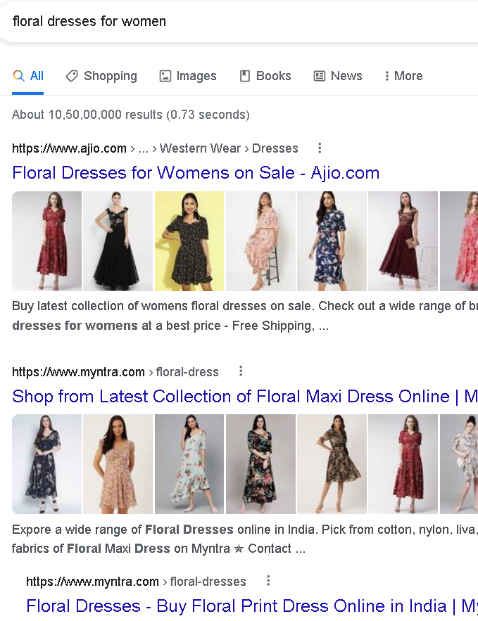
The content format works mainly for blogs as they are generally listicles, how-tos, articles, news, review, and opinion pieces.
The content angle is not clear cut and is the key “selling point” of the content. The perfect content angle is a user’s guess. So, go for the angle that you think would appeal and benefit searchers the most.
You should not follow the crowd when it comes to aligning your content with searchers’ expectations. To get the searcher’s attention with a unique type, format, and angle, you should keep on experimenting.
Detailing
To get displayed on the first page of SERPs, your content should comprise all the elements that your target customers expect to see on the search results. Once you identify the 3Cs of search intent, you get the idea of what searchers may want to see.
If you evaluate the 3Cs, you get a clear view of intent. To understand your content elements, you need to research further by assessing relevant top-ranking web pages. Many web pages break a topic into subtopics with subheads, which helps you to understand what searchers look for, mainly if you see the same subheads across several pages.
When writing a listicle, look to subheadings for information related to certain products or services that you may feel like including. Find keyword intersections and common subheadings between several pages to analyze them more effectively. Then, you can structure your content for searchers adding the elements they care about the most.
Besides analyzing pages, you can check SERP features such as “People Also Ask” boxes and featured snippets.
Uniqueness
Your searchers should always get what they want but you should offer them something unique. If your content is as same as many other website contents, no one would prefer to link to your content. You need to be creative at your best when writing website content.
Embed videos in your posts to attract traffic from Google. When a user visits your page, likes the tips you share, and feels like sharing it with others, they would have no other option than sharing or linking to your page.
You may find it tough to build a unique product/category page, but you can use high-quality filters, product photography, unique descriptions, and reviews.
Clarity
Your content may align with search intent but nobody will read if it’s vague. To write clear content, add the following elements to it:
- Bullets
- Descriptive subheadings (H2 to H6) for hierarchy
- Images for a visual break
- Simple words and short sentences/paragraphs
- Large fonts
- Verbal language
You need to know what it takes for searchers to find the information they are looking for. When your website has everything that people want to know but can’t find, they tend to hit the “Back” button to look for a web page with clear information.
How to Optimize for On-Page SEO
Knowing the factors influencing your on-page SEO is not enough. You need to know how to optimize that. It takes time to optimize your website components and get the desired results.
But if you follow these tips below, depending on different factors, you can build a well-optimized website:
Keywords are words used for SEO purposes to target trending search queries. Add relevant keywords to every page on your website to describe the topic. If you add keywords throughout the website content, Google can read and rank it high on SERPs. Web pages that are not well-optimized, like the “Contact Us” page, can even help your brand gain a massive online presence.
You can research and collect keywords for every page on your website. Use keyword research tools to understand the keywords users search for your products and services. Check the valuable metrics, such as competition and monthly search volume, to find the keywords that add a high value to your website content.
The content in the screenshot above shows how the writer has added the keyword, “SEO Services” to return on the search engines for that keyword and reach the target audience. Many companies use long-tail keywords(3 to 4 words) with lower monthly search volumes and competition. You can easily find the search intent behind long keywords as they are more specific.
When people search for short-term keywords, they can’t understand exactly what they want. Depending on your business objectives, you can add both short-term and long-term keywords to your SEO campaigns.
URL
URL is like an address for a web page on the internet. It needs to have a short description of your web page topic.

You should add relevant keywords(“SEO Services” in the screenshot above) to your URL rather than a string of numbers as that makes your website easy to navigate and help people easily understand the page topics. Always use proper URLs to improve your website framework and search engine rankings.
Heading Tags
Heading tags are those that segregate content with H1, H2s, H3s, and H4s to improve content readability(check the image below).
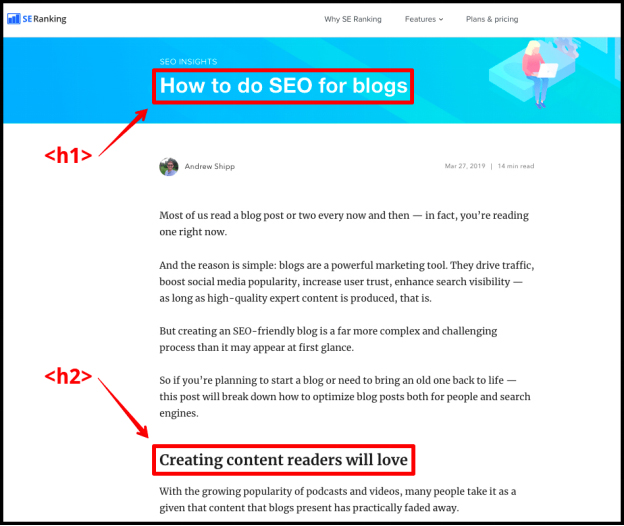
Source: SERanking
You need to use headings tags for readers and search engines. Make you use them throughout your content in such a way that it improves readability. The image above shows “How to do SEO for blogs” as H1 and “Creating content readers will love” H2.
Including main or relevant keywords to provide more context to search engines for your web page can be an intelligent step. When writing heading tags, make sure you target the main keyword in your H1.
Title Tags
A title tag is a web page title that only displays in SERPs. To display your website in SERPs, Google needs to understand what your web page is all about. When you use specific keywords in the title of every page (<title>, </title>), search engine crawlers can easily read your website.

The screenshot above displays a meta description(“get more customers with affordable SEO services” that targets the keywords “SEO services” and “affordable SEO services”. To rank high on SERPs and prevent cutting your title tag in the Google search result, keep it within 55 characters.
Meta Descriptions
A meta description is a web page content summary that displays in SERPs. It doesn’t directly boost on-page SEO but helps users learn about your page. As Google bolds user search terms displayed in your meta description, you should optimize your meta description for on-page SEO.
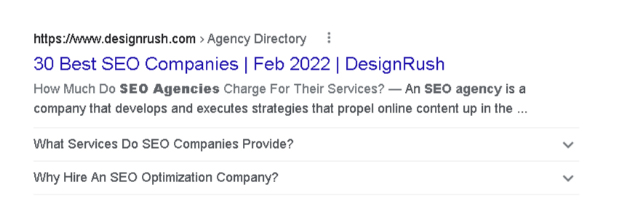
The meta description you can see in the screenshot above bolds the keyword “SEO agency.”
You should add main and relevant keywords to your meta description for the desired search engine results. Make sure your meta description does not exceed 160 characters.
Content
Your content gives replies to users and context to search engines. Users repeatedly visit your website to check a product page or read a blog if you have excellent web content. Content optimization helps search engines interpret and rank your website high on SERPs.
Here are the things that you should do to optimize your content for on-page SEO:
- Add relevant keywords to headings, sub-headings, and paragraphs.
- Break content into headings(H1.H2.H3 and H4).
- Include images to increase the value of your content.
- Make sure the spellings and grammar are correct in your content.
- Build trust with your content.
- Add new content(blog posts and landing pages) to your website frequently, so search engines understand you are active online.
- Identify and delete duplicate content as search engines tend to get confused about which page to rank. Moreover, website visitors get confused when taking a step. As duplicate content adversely affects your on-page SEO, you should frequently check your website to identify and remove similar content.
Mobile-Friendliness
Mobile-friendliness reflects your website’s accessibility on mobile devices. You should have a mobile-friendly website as over 50% of the online traffic you get from such devices. Your website ranking automatically degrades if tablet and smartphone users can’t access it. Search engines consider mobile-friendliness as a search engine ranking factor. Thus, you miss high-quality leads and revenue if your website is not optimized for mobile devices.
Make sure you build a responsive website as it helps you add new content and upgrade your website.
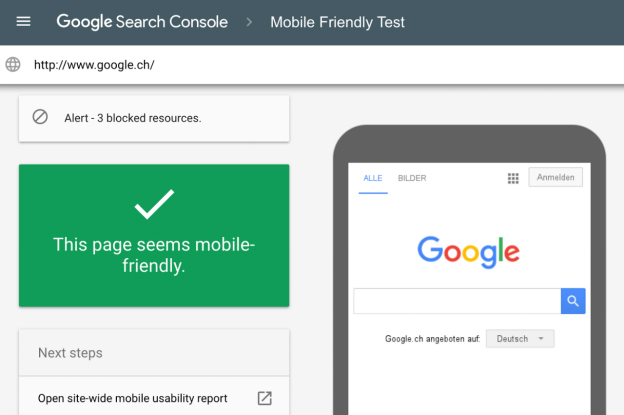
Take the “mobile-friendly test” mentioned above to check your website responsiveness.
Images
Images are a type of multimedia that helps internet users to understand your website content, break up your content and improve on-page SEO. Images make your website more user-friendly and boost search engine ranks.
With images, you can easily describe complicated concepts or features. Make sure you compress images before using those as oversized multimedia slows down your website. Images make your website more user-friendly and boost search engine ranks.

Don’t forget to add Alt text for images in the “Image Settings”(check the photo above) and transcripts for videos. Adding target keywords to Alt text can make your website ADA compliant.
ALT Tags
Use ALT tags as they give more information regarding images and videos. Search engines can’t see multimedia, so they read ALT tags to understand them.
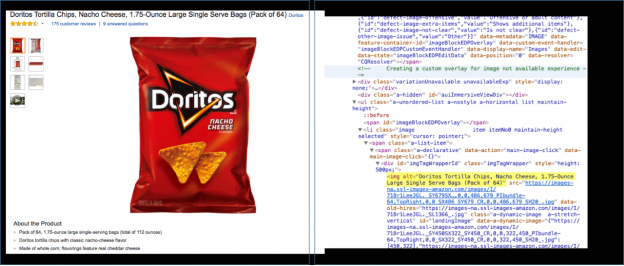
Source: Moz
The portion in the image above highlighted yellow is the ALT tag for the “Doritos Nacho Cheese” picture. Besides the ALT tag, you can add descriptive names to image files so Google can understand your multimedia. ALT tags also help people who can’t see or access your web content and makes your website accessible to all users.
Internal Linking
Internal linking is linking to and from your website pages. With the evolution of your website, you should prioritize internal linking as that helps search engine crawlers to crawl your site. The crawlers can find new content and interpret the context of various web pages.
If your website has little interlinking, users tend to miss out on accessing valuable content on your website, which decreases your conversion rates. Add links to/from relevant and old content in/to new web pages.
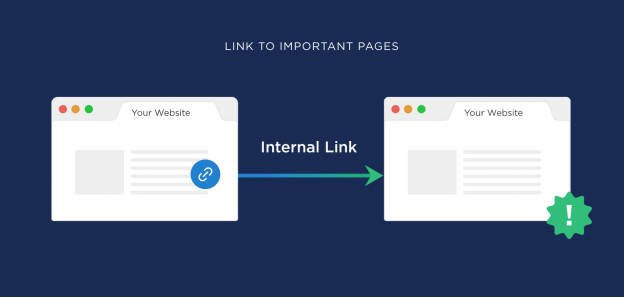
Source: Backlinko
You can implement various internal linking strategies. Just ensure every new web page has 2 to 3 links and never force interlinking. Create pillar content if you can’t find relevant content on other web pages.
Page Speed
Page speed estimates the speed at which your content on a web page loads. Users have a minimal attention span, and 53% of them can leave a page if it takes more than 3 seconds to load. Remember, people always want instant information online. Search engines consider page speed as a ranking determinant.
To optimize your web page speed, you should control its speed. If your website loads faster, it can fetch a high rank on search engine results. PageSpeed Insights is an excellent tool to speed up your website. Follow specific page speed optimization tactics such as compressing image sizes and deleting extra coding.
Advanced On-Page SEO Techniques
Once you are done following the basic on-page SEO techniques, you need to level up implementing the advanced tactics below:
Featured Snippets
Featured snippets display above other organic search results and thus, are highly valuable. They are of various forms – Definitions, Tables, Lists, and Videos.
As featured snippets display in “position 0”, they help to increase CTR. You need to find out if you have featured snippets for keywords you track and if you have extra opportunities. You can see which site has your preferred snippet and structured the content on their website to boost CTRs.
Consider competitor research and check what the features snippet contains that yours doesn’t have. See if it has a user-friendly and concise query definition, directly replies to the question with sufficient detail and has a useful list matched to the search intent.
You can restructure your content depending on the featured snippet in question and target keywords to deliver a better UX.
Page Speed
Google has said that page speed is a ranking signal for desktops and mobile devices. You can use the free Google PageSpeed Insights tool to get a Performance Score for both desktops and mobile devices. The tool also delivers actionable suggestions to improve ranking.
Senrush, via the Site Audit tool, helps you to learn more regarding your website performance. The Core Web Vitals report shows if any specific page has slowed down your website and how you can increase the speed.
Schema Markup
Schema Markup is possibly the technical component of advanced on-page SEO and a kind of digital road map for Google bots. Google uses automated bots to assist them in crawling, indexing, and delivering your web content.
Google depends on a simple and technical language, called Schema Markup, to understand your website content and how the pages are related. The coding vocabulary is also called structured data.
Schema markup signals when content is regarding events, products, people, recipes, reviews, medical conditions, organizations, and local businesses. The schema markup used by websites promoting events helps Google learn that they can feature such events more prominently in search results.
A Schema Markup looks like a lot of code. If you are willing to attempt creating structured data, check out the Google Schema Markup Testing tool to ensure you have created the code correctly. After you implement the coding, focus on Sutw Audit to identify any issues with structured data.
How to Monitor Your and Competitor’s On-Page Optimization
After optimizing your website for on-page SEO, you should monitor its performance by using tools or manually. Check if every page has relevant keywords that are delivering users, you are linking pages with each other in your website and posting content frequently. Remember, your site should always load quickly as a slow website irritates visitors. So, you should find and fix those issues immediately that slow down your website.
When monitoring your competitor’s SEO, visit their website to find out what they are doing presently. Competitor website analysis helps you to understand which areas in your website need improvement. Once you work on your on-page SEO, you can see your website rank high on SERPs.
The Bottom Line
So, that’s all you need to know about on-page SEO, how to optimize your website, monitor your and competitors’ on-page SEO performance. The competition is extremely tough in today’s business world, you should not lag because of poor on-page SEO.
Make sure you implement the most-effective on-page optimization techniques as mentioned above to get the desired rank on SERPs. As mentioned earlier, you can hire professionals to work on on-page SEO and grow your business significantly.
Let PageTraffic give you the right on-page SEO help!
We know you have a lot on your plate, so we’ll take care of all the hard work for you. With two decades in the industry and an award-winning team that has seen it all when it comes to SEO strategies, our professional services will leave your competitors behind! Contact us today to discuss your requirements.
